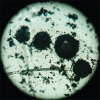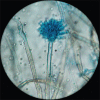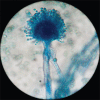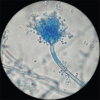Aspergillus species: An emerging pathogen in onychomycosis among diabetics
- PMID: 26693433
- PMCID: PMC4673811
- DOI: 10.4103/2230-8210.167565
Aspergillus species: An emerging pathogen in onychomycosis among diabetics
Abstract
Introduction: Approximately, 33% patients with diabetes are afflicted with onychomycosis. In the past, nondermatophyte molds have been regarded as opportunistic pathogens; recently, Aspergillus species are considered as emerging pathogens of toenail infections. In Sri Lanka, the prevalence of Aspergillus species in onychomycosis among diabetics is not well documented.
Objective: To determine the proportion of Aspergillus onychomycosis, risk factors and knowledge among diabetics.
Materials and methods: This was descriptive cross-sectional study. Three hundred diabetic patients were included. Clinical examinations of patients' toenails were performed by a clinical microbiologist. Laboratory identification was done, and pathogens were identified to the species level by morpho-physiological methods. All inferential statistics were tested at P < 0.05.
Results: Among clinically suspected patients, 85% (255/300) were mycologically confirmed to have onychomycosis. Aspergillus species were most commonly isolated n = 180 (71%) followed by dermatophytes, yeasts, and other molds n = 75 (29%). Of the patients having Aspergillus onychomycosis, 149 (83%) were in the > age group. In men, Aspergillus onycomycosis was seen in 82%. Among patients who had Aspergillus nail infection, 114 (63%) had diabetes for a period of > years. Among patients who were engaged in agricultural activities, 77% were confirmed to have infected nails due to Aspergillus species.
Conclusion: Aspergillus niger was the most common pathogen isolated from toenail infection. Aspergillus species should be considered as an important pathogen in toenail onychomycosis in diabetic patients. Risk factors associated with Aspergillus onychomycosis were age, gender, duration of diabetes, length of exposure to fungi, and occupation.
Keywords: Aspergillus species; Sri Lanka; diabetics; onychomycosis.
Figures






Similar articles
-
Aspergillus species as emerging causative agents of onychomycosis.J Mycol Med. 2015 Jun;25(2):101-7. doi: 10.1016/j.mycmed.2014.12.001. Epub 2015 Feb 2. J Mycol Med. 2015. PMID: 25656408
-
Epidemiology of Onychomycosis in Chinese Mainland: A 30-year Retrospective Study.Mycopathologia. 2022 Aug;187(4):323-331. doi: 10.1007/s11046-022-00647-4. Epub 2022 Jul 10. Mycopathologia. 2022. PMID: 35819711
-
The change of causative pathogens in toenail onychomycosis.J Cosmet Dermatol. 2021 Jul;20(7):2311-2316. doi: 10.1111/jocd.13819. Epub 2020 Nov 11. J Cosmet Dermatol. 2021. PMID: 33179427
-
Mycology of nail disorders.J Am Acad Dermatol. 1994 Sep;31(3 Pt 2):S68-74. doi: 10.1016/s0190-9622(08)81272-8. J Am Acad Dermatol. 1994. PMID: 8077512 Review.
-
Itraconazole and terbinafine treatment of some nondermatophyte molds causing onychomycosis of the toes and a review of the literature.J Cutan Med Surg. 2001 May-Jun;5(3):206-10. doi: 10.1007/s102270000019. Epub 2001 May 2. J Cutan Med Surg. 2001. PMID: 11685666 Review.
Cited by
-
Comparative Study of Traditional Ablative CO2 Laser-Assisted Topical Antifungal with only Topical Antifungal for Treating Onychomycosis: A Multicenter Study.Clin Drug Investig. 2020 Jun;40(6):575-582. doi: 10.1007/s40261-020-00914-6. Clin Drug Investig. 2020. PMID: 32314298
-
Zombie Cells, Composite Cells of Fungal-Human Keratinocytes of Plantar Hyperkeratosis-Like Lesions.Mycopathologia. 2019 Oct;184(5):597-605. doi: 10.1007/s11046-019-00369-0. Epub 2019 Aug 2. Mycopathologia. 2019. PMID: 31376042
-
Onychomycosis in Patients with Diabetes Mellitus in Africa: A Global Scoping Review, 2000-2021.Mycopathologia. 2023 Jun;188(3):173-182. doi: 10.1007/s11046-022-00660-7. Epub 2022 Sep 3. Mycopathologia. 2023. PMID: 36057068
-
A 9-Year Experience of Aspergillus Infections from Isfahan, Iran.Infect Drug Resist. 2020 Jul 14;13:2301-2309. doi: 10.2147/IDR.S259162. eCollection 2020. Infect Drug Resist. 2020. PMID: 32765006 Free PMC article.
-
A Review of Onychomycosis Due to Aspergillus Species.Mycopathologia. 2018 Jun;183(3):485-493. doi: 10.1007/s11046-017-0222-9. Epub 2017 Nov 16. Mycopathologia. 2018. PMID: 29147866 Free PMC article. Review.
References
-
- Papini M, Cicoletti M, Fabrizi V, Landucci P. Skin and nail mycoses in patients with diabetic foot. G Ital Dermatol Venereol. 2013;148:603–8. - PubMed
-
- Mayser P, Freund V, Budihardja D. Toenail onychomycosis in diabetic patients: Issues and management. Am J Clin Dermatol. 2009;10:211–20. - PubMed
-
- Cathcart S, Cantrell W, Elewski BE. Onychomycosis and diabetes. J Eur Acad Dermatol Venereol. 2009;23:1119–22. - PubMed
LinkOut - more resources
Full Text Sources
Other Literature Sources
Miscellaneous

